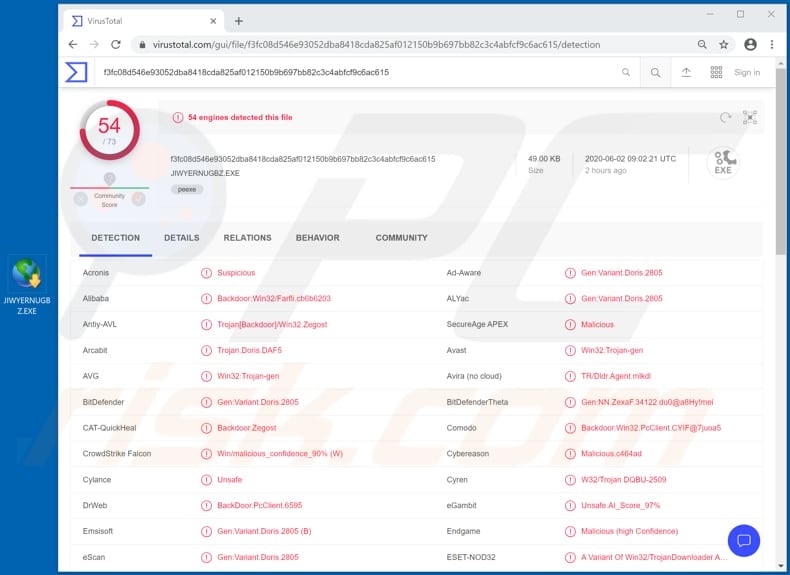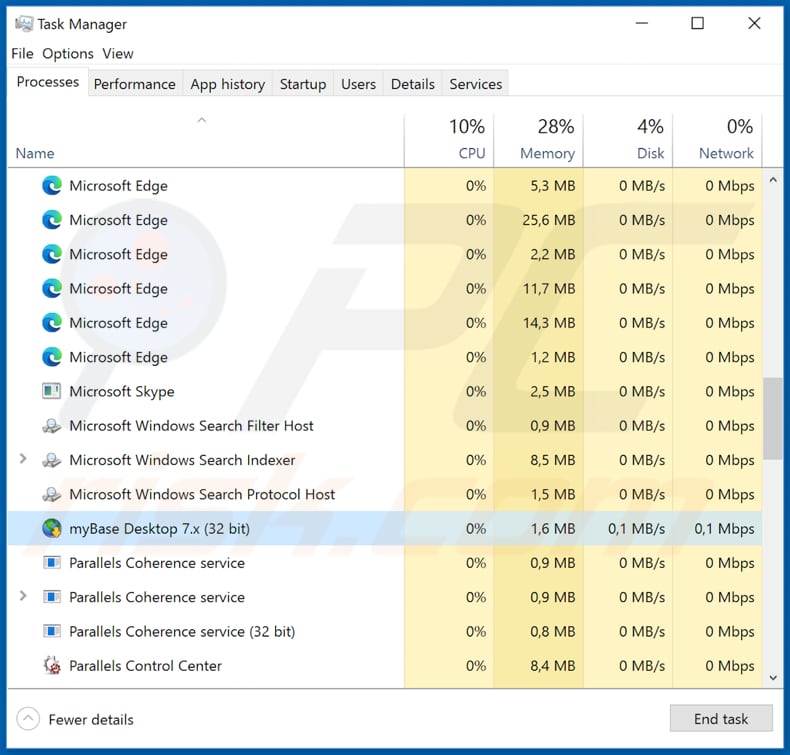Get free scan and check if your device is infected.
Remove it nowTo use full-featured product, you have to purchase a license for Combo Cleaner. Seven days free trial available. Combo Cleaner is owned and operated by RCS LT, the parent company of PCRisk.com.
What is Dupzom?
Dupzom is a Trojan which operates as a malware downloader. It causes chain infections by downloading and executing malicious files that infect computers with additional malware. Dupzom can cause installation of ransomware, remote administration/access Trojans (RATs), cryptocurrency miners, and other high-risk malware.
Therefore, if there is any reason to believe that your computer is infected with Dupzom or other similar malware, remove these threats immediately.

Commonly, Trojans such as Dupzom are used to distribute ransomware. Victims of ransomware attacks cannot access their files, since the software encrypts them with strong encryption algorithms. Typically, on the cyber criminals behind specific ransomware have tools/keys that can decrypt files that were encrypted by it.
RATs are another type of malware infection that cyber criminals often distribute through these downloaders. When a RAT is installed on the computer, it allows cyber criminals to control the victim's device remotely.
The software enables them to access files, acquire login credentials (and other personal information), download and execute various files (including malicious files), take screenshots, access webcams, microphones, and perform other actions.
Furthermore, Dupzom can be used to install cryptocurrency miners - these programs use computer resources (such as GPU, CPU) to mine cryptocurrency by solving complex mathematical problems. In summary, cyber criminals attempt to infect computers with these programs in order to generate revenue.
Infected computers begin to work more slowly (or do not respond at all) and consume more electricity. Installed miners might also cause unexpected system crashes/shutdowns leading to permanent loss of unsaved data.
In summary, computers infected with Dupzom can be the reason behind of installation of other malware, which can then cause problems such as data and monetary loss, loss of sensitive information, issues relating to online privacy, browsing safety, identity theft, and other serious issues.
| Name | Dupzom malware downloader |
| Threat Type | Trojan, password-stealing virus, banking malware, spyware. |
| Detection Names | Avast (Win32:Trojan-gen), BitDefender (Gen:Variant.Doris.2805), ESET-NOD32 (A Variant Of Win32/TrojanDownloader.Agent.CXA), Kaspersky (Backdoor.Win32.Farfli.brzh), Full List (VirusTotal). |
| Malicious Process Name(s) | myBase Desktop 7.x (its name might vary). |
| Payload | Dupzom can be used to distribute a variety of malicious programs. |
| Symptoms | Trojans are designed to stealthily infiltrate the victim's computer and remain silent, and thus no particular symptoms are clearly visible on an infected machine. |
| Distribution methods | Infected email attachments, malicious online advertisements, social engineering, software 'cracks'. |
| Damage | Stolen passwords and banking information, identity theft, the victim's computer added to a botnet. |
| Malware Removal (Windows) |
To eliminate possible malware infections, scan your computer with legitimate antivirus software. Our security researchers recommend using Combo Cleaner. Download Combo CleanerTo use full-featured product, you have to purchase a license for Combo Cleaner. 7 days free trial available. Combo Cleaner is owned and operated by RCS LT, the parent company of PCRisk.com. |
More examples of malware that operate in a similar way to Dupzom (and are designed to spread other malware) include HimeraLoader, Ostap, and ZLoader. Cyber criminals behind these programs use them to cause installation of other malware, which enables them to generate revenue.
Typically, users download and install software such as Dupzom unintentionally. Examples of how computers become infected with malicious software (including malware downloaders such as Dupzom) are provided in the next paragraph.
How did Dupzom infiltrate my computer?
People often install malware through spam campaigns, untrusted software download channels, software 'cracking' tools and fake software updaters. Malware installation through spam campaigns (emails) happen when recipients open/execute malicious attachments, or web links that download malicious files, included in emails.
Typically, cyber criminals attach malicious Microsoft Office, PDF documents, executable files (.exe), archive files such as RAR, ZIP or JavaScript files. Malicious programs also infiltrate through software download channels, which should never be trusted.
For example, Peer-to-Peer networks such as torrent clients, eMule, free file hosting websites, third party downloaders, freeware download pages, unofficial websites, and so on. These channels are used to distribute malicious files by disguising them as harmless and legitimate.
When users download and open/execute them, however, they install malicious software. Unofficial activation ('cracking') tools are unofficial programs that supposedly activate licensed software free of charge, however, they do not activate any programs and simply infect computers with high-risk malware instead.
Unofficial software updating tools infect systems by installing malware rather than updates/fixes for installed software, or by exploiting bugs/flaws of outdated software.
How to avoid installation of malware
Do not to open file attachments or website links that are presented in irrelevant emails or those received from unknown, suspicious addresses. The safest option is to ignore them (leave them unopened). All files and programs should be downloaded only from official and trustworthy websites and through direct links.
Unofficial websites, third party downloaders, installers, Peer-to-Peer networks, and other channels of this type are used to distribute malicious files and programs. Software and operating systems must be updated and activated via implemented functions and tools that are designed by official developers.
Third party tools cause installation of malware. Software should never be activated through third party, unofficial tools, since this is illegal. Have reputable antivirus or anti-spyware software installed on the operating system and perform scans with it regularly. Keep this software up to date.
If you believe that your computer is already infected, we recommend running a scan with Combo Cleaner Antivirus for Windows to automatically eliminate infiltrated malware.
Dupzom malicious process running in Task Manager as "myBase Desktop 7.x" (its name might vary):

Instant automatic malware removal:
Manual threat removal might be a lengthy and complicated process that requires advanced IT skills. Combo Cleaner is a professional automatic malware removal tool that is recommended to get rid of malware. Download it by clicking the button below:
DOWNLOAD Combo CleanerBy downloading any software listed on this website you agree to our Privacy Policy and Terms of Use. To use full-featured product, you have to purchase a license for Combo Cleaner. 7 days free trial available. Combo Cleaner is owned and operated by RCS LT, the parent company of PCRisk.com.
Quick menu:
How to remove malware manually?
Manual malware removal is a complicated task - usually it is best to allow antivirus or anti-malware programs to do this automatically. To remove this malware we recommend using Combo Cleaner Antivirus for Windows.
If you wish to remove malware manually, the first step is to identify the name of the malware that you are trying to remove. Here is an example of a suspicious program running on a user's computer:

If you checked the list of programs running on your computer, for example, using task manager, and identified a program that looks suspicious, you should continue with these steps:
 Download a program called Autoruns. This program shows auto-start applications, Registry, and file system locations:
Download a program called Autoruns. This program shows auto-start applications, Registry, and file system locations:

 Restart your computer into Safe Mode:
Restart your computer into Safe Mode:
Windows XP and Windows 7 users: Start your computer in Safe Mode. Click Start, click Shut Down, click Restart, click OK. During your computer start process, press the F8 key on your keyboard multiple times until you see the Windows Advanced Option menu, and then select Safe Mode with Networking from the list.

Video showing how to start Windows 7 in "Safe Mode with Networking":
Windows 8 users: Start Windows 8 is Safe Mode with Networking - Go to Windows 8 Start Screen, type Advanced, in the search results select Settings. Click Advanced startup options, in the opened "General PC Settings" window, select Advanced startup.
Click the "Restart now" button. Your computer will now restart into the "Advanced Startup options menu". Click the "Troubleshoot" button, and then click the "Advanced options" button. In the advanced option screen, click "Startup settings".
Click the "Restart" button. Your PC will restart into the Startup Settings screen. Press F5 to boot in Safe Mode with Networking.

Video showing how to start Windows 8 in "Safe Mode with Networking":
Windows 10 users: Click the Windows logo and select the Power icon. In the opened menu click "Restart" while holding "Shift" button on your keyboard. In the "choose an option" window click on the "Troubleshoot", next select "Advanced options".
In the advanced options menu select "Startup Settings" and click on the "Restart" button. In the following window you should click the "F5" button on your keyboard. This will restart your operating system in safe mode with networking.

Video showing how to start Windows 10 in "Safe Mode with Networking":
 Extract the downloaded archive and run the Autoruns.exe file.
Extract the downloaded archive and run the Autoruns.exe file.

 In the Autoruns application, click "Options" at the top and uncheck "Hide Empty Locations" and "Hide Windows Entries" options. After this procedure, click the "Refresh" icon.
In the Autoruns application, click "Options" at the top and uncheck "Hide Empty Locations" and "Hide Windows Entries" options. After this procedure, click the "Refresh" icon.

 Check the list provided by the Autoruns application and locate the malware file that you want to eliminate.
Check the list provided by the Autoruns application and locate the malware file that you want to eliminate.
You should write down its full path and name. Note that some malware hides process names under legitimate Windows process names. At this stage, it is very important to avoid removing system files. After you locate the suspicious program you wish to remove, right click your mouse over its name and choose "Delete".

After removing the malware through the Autoruns application (this ensures that the malware will not run automatically on the next system startup), you should search for the malware name on your computer. Be sure to enable hidden files and folders before proceeding. If you find the filename of the malware, be sure to remove it.

Reboot your computer in normal mode. Following these steps should remove any malware from your computer. Note that manual threat removal requires advanced computer skills. If you do not have these skills, leave malware removal to antivirus and anti-malware programs.
These steps might not work with advanced malware infections. As always it is best to prevent infection than try to remove malware later. To keep your computer safe, install the latest operating system updates and use antivirus software. To be sure your computer is free of malware infections, we recommend scanning it with Combo Cleaner Antivirus for Windows.
Share:

Tomas Meskauskas
Expert security researcher, professional malware analyst
I am passionate about computer security and technology. I have an experience of over 10 years working in various companies related to computer technical issue solving and Internet security. I have been working as an author and editor for pcrisk.com since 2010. Follow me on Twitter and LinkedIn to stay informed about the latest online security threats.
PCrisk security portal is brought by a company RCS LT.
Joined forces of security researchers help educate computer users about the latest online security threats. More information about the company RCS LT.
Our malware removal guides are free. However, if you want to support us you can send us a donation.
DonatePCrisk security portal is brought by a company RCS LT.
Joined forces of security researchers help educate computer users about the latest online security threats. More information about the company RCS LT.
Our malware removal guides are free. However, if you want to support us you can send us a donation.
Donate
▼ Show Discussion